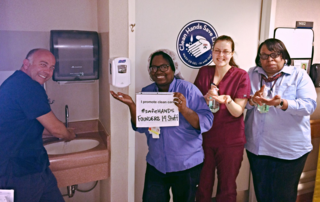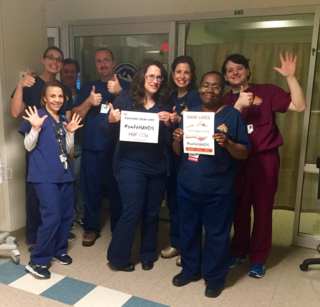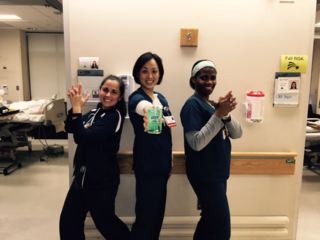 For the past several years, the Hospital of the University of Pennsylvania – along with many other U.S. hospitals -- has focused on lowering the rate of HAIs (health-care associated infections), using team work and many proven strategies to prevent the infections before they start. But studies show that the best way to do this is also the most basic: washing your hands.
For the past several years, the Hospital of the University of Pennsylvania – along with many other U.S. hospitals -- has focused on lowering the rate of HAIs (health-care associated infections), using team work and many proven strategies to prevent the infections before they start. But studies show that the best way to do this is also the most basic: washing your hands.
As PJ Brennan, MD, chief medical officer for Penn Medicine, wryly noted, “If you do everything else but that, what’s the point?”
Understanding the importance of washing hands is nothing new; it dates back to the 1800s. “One of the earliest infectious disease landmark studies – from the pre-antibiotic era – showed a reduction in infection,” said Emily Blumberg, MD, director of Infectious Disease in Transplantation/Medicine.
According to Rachel Reis, BSN, RN, Infection Prevention specialist, the World Health Organization established “5 moments for hand hygiene” for anyone who cares for – or even comes in contact with – patients. “It’s important to involve everyone,” Blumberg said. “Not only nurses and doctors but respiratory therapists, CNAs [certified nursing assistants], medical students, support staff and others who enter the patient’s room.”
 Proper hand hygiene, i.e., clean hands, is a priority at HUP. Each unit has a hand hygiene champion to help increase compliance and the hospital’s hand hygiene committee holds quarterly activities to keep the issue on everyone’s radar. For example, this past Halloween, they held a “What’s Haunting Your Unit” contest, asking each unit to create a poster with information on its most common organisms. And, in keeping with the March Madness spirit, committee members created their own competition, pitting units against each other for the best hand hygiene compliance rates.
Proper hand hygiene, i.e., clean hands, is a priority at HUP. Each unit has a hand hygiene champion to help increase compliance and the hospital’s hand hygiene committee holds quarterly activities to keep the issue on everyone’s radar. For example, this past Halloween, they held a “What’s Haunting Your Unit” contest, asking each unit to create a poster with information on its most common organisms. And, in keeping with the March Madness spirit, committee members created their own competition, pitting units against each other for the best hand hygiene compliance rates.
For Hand Hygiene Day last month, the committee pulled out all the stops. “All the champions took photos of staff performing good hand hygiene and we used social media to get the word out,” said Reis. They tweeted the photos – and the hashtag #safehands”—on Penn Medicine’s Twitter to Duke, UCLA, and other health systems, and posted on Facebook and Instagram to get out the message and engage others: “Here’s our hand hygiene. Show us yours!”
“This allowed us to join with institutions globally to show our commitment,” Reis said.
Starting next month, committee members will do walk rounds on every unit. “The unit champions track staff cleaning their hands when entering and leaving patient rooms and forward this information to us,” explained Suzanna Ho, RN, MSN, coordinator of Patient Safety and Quality Nursing. “On these monthly walk rounds, we’ll talk to staff on each unit about their rates and how to improve them.”
 While health-care providers and support staff understand the importance of proper hand hygiene, there are challenges, Reis said. For example, sometimes a nurse might enter a room just to check on a patient with no plans for any contact, but “the patient needs something in the room so the nurse says ‘Let me just grab that for you.’”
While health-care providers and support staff understand the importance of proper hand hygiene, there are challenges, Reis said. For example, sometimes a nurse might enter a room just to check on a patient with no plans for any contact, but “the patient needs something in the room so the nurse says ‘Let me just grab that for you.’”
Another misconception is that you don’t need to wash hands if you’re wearing gloves. “You need to wash your hands before donning gloves and after removing them, even if you’re putting on clean gloves,” Reis stressed.
“Gloves don’t make your hands a sterile field,” added Blumberg.
To ensure that staff have the necessary resources to perform good hand hygiene, HUP began putting up Purell (alcohol-based) dispensers on units – and around the hospital -- nearly five years ago. Today, a typical unit with 20 beds has between 70 and 75 dispensers. And the ED has even more.
“No one is immune from making mistakes,” Blumberg said, but the constant reminders increase awareness and identify potential barriers to 100 percent compliance.
Bottom line: “You should be washing your hands a lot,” Reis stressed. “It seems simple but it’s very effective.”
The 5 Moments for Hand Hygiene:
- Before entering a patient’s room.
- Before performing any aseptic procedure.
- After any exposure to body fluid.
- After any patient contact.
- After contact with any patient surroundings, ie, any object or furniture in the patient’s immediate surrounding.